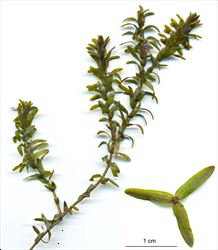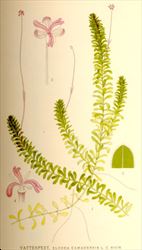Click on images to enlarge

Canadian Waterweed, Elodea canadensis (with enlarged cross section of a single whorl). Christian Fischer [CC BY-SA 3.0 (http://creativecommons.org/licenses/by-sa/3.0)], via Wikimedia Commons

Canadian Waterweed (Elodea canadensis) in a shallow ditch. Christian Fischer [CC BY-SA 3.0 (http://creativecommons.org/licenses/by-sa/3.0)], via Wikimedia Commons

Carl Axel Magnus Lindman [Public domain or Public domain], via Wikimedia Commons.
Scientific Name
Elodea canadensis Michx.
Synonyms
Anacharis canadensis (Michx.) Planch.
Family
Hydrocharitaceae
Common Names
American duckweed, American elodea, American waterweed, anacharis, Canadian elodea, Canadian pond weed, Canadian pondweed, Canadian waterweed, common waterweed, elodea, oxygen weed, waterweed
Origin
This species is native to the temperate regions of North America (i.e. Canada and USA).
Cultivation
This species has been widely cultivated in the aquarium industry, particularly in the temperate regions of Australia.
Naturalised Distribution
This species has become naturalised in water bodies in the south-eastern parts of Australia, particularly in areas near major cities. It is most common in southern and eastern New South Wales, Victoria and Tasmania. Also recorded from south-eastern South Australia and sparingly naturalised in south-eastern Queensland.
Habitat
This weed grows in a wide range of climates but is predominantly found in temperate regions. It is an aquatic species that infests slow-moving waterways, lakes, wetlands, dams, ponds and garden water features.
Habit
A long-lived (i.e. perennial) freshwater plant that is usually rooted to the soil (i.e. substrate) and forms a dense mass of vegetation below the water surface (i.e. it is submerged).
Distinguishing Features
- a long-lived underwater plant with stems (up to 6 m long) that are usually anchored to the soil.
- its oblong or elongated leaves (5-20 mm long and 1-5 mm wide) are usually found in groups of three at each stem joint.
- these leaves are stalkless with minutely toothed margins.
- its small white flowers are borne just above the water surface on underwater 'stalks' up to 30 cm long.
- these flowers have three slender petals (up to 5 mm long).
Stems and Leaves
The slender stems (1-2 mm thick) are branched and grow up to 6 m long, but are usually less than 3 m in length. They are produced off short runners (i.e. stolons), develop long thread-like roots (i.e. adventitious roots) from the joints near their bases (i.e. basal nodes), and grow up towards the water surface. The stem joints (i.e. nodes) and leaves are wider apart near the base of the stems (up to 25 mm apart) but become more crowded towards their tips (as little as 3 mm apart).
The leaves are usually borne in groups (i.e. whorls) of three (rarely four) at each stem joint (i.e. node), but the lower leaves are oppositely arranged, smaller and broader. These small leaves are oblong or elongated in shape (5-20 mm long and 1-5 mm wide) with minutely toothed (i.e. serrulate) or entire margins. They are dark green in colour, stalkless (i.e. sessile), and partially see-through (i.e. translucent).
Flowers and Fruit
Male and female flowers are borne on separate plants (i.e. they are unisexual) and only male plants and male flowers are found in Australia. The small whitish flowers have three slender petals (about 5 mm long), three sepals (3.5-5 mm long) and nine stamens. They are borne just above the water surface on an underwater 'stalk' (i.e. hypanthium) usually 2-15 cm long (occasionally up to 30 cm long). These 'stalks' (i.e. hypanthia) are initiated from the upper leaf forks (i.e. axils). Flowering occurs mostly during late spring and summer.
As female plants are not present in Australia, fruit and seeds are not produced here.
Reproduction and Dispersal
As female plants are not present in Australia, all reproduction is vegetative (i.e. asexual) via stem fragments or runners (i.e. stolons).
The runners (i.e. stolons) allow a colony to increase in size and spread laterally across a water body. Stem fragments are spread along waterways by water movement (particularly during floods) and are usually introduced into new water bodies in dumped aquarium waste or by contaminated vehicles.
Environmental Impact
Elodea (Elodea canadensis) is regarded as an environmental weed in Victoria, New South Wales and Tasmania. It commonly invades still or slow-moving freshwater environments and thrives in temperate regions. Infestations of this species compete with desirable aquatic plants, resulting in modified aquatic flora assemblages and habitats. Like most aquatic weeds, high nutrient loads in the water will result in more vigorous growth of this species.
Elodea (Elodea canadensis) is currently most troublesome in eastern New South Wales and Victoria. It is common in many rivers and streams in the Central Coast and Hunter regions, and is regarded as a weed of particular significance to this region. A large outbreak was recently reported in wetlands in the Endeavour Hills area, near Melbourne in Victoria. In Tasmania, elodea (Elodea canadensis) has been recorded in several lakes, ponds, creeks and rivers (e.g. in the Derwent, Macquarie, Mersey and Jordan river systems, in Brumby’s Creek, and in Arthurs Lake, Lake Leake and Little Pine Lagoon) and is most prevalent in the Central Highlands region of this state.
Other Impacts
Elodea (Elodea canadensis) is regarded as a major weed of irrigation systems in New South Wales. Dense infestations of this species can reduce water flow in waterways and obstruct irrigation channels. For example, water flow in some larger irrigation canals in New South Wales has been reduced to 60% of design capacity, sometimes causing them to overflow. Infestations also block inlet pipes, clog pumps, and interfere with recreational activities such as swimming, boating and fishing.
Legislation
This species is declared under legislation in the following states and territories:
- Northern Territory: C - not to be introduced into the Territory.
- South Australia: 1@ - this species is declared in Class 1a and is a prohibited aquatic weed. Its presence must be notified and the plant must be destroyed (throughout the entire state).
- Tasmania: D - the importation or sale of this species is prohibited and measures to reduce its population in an area, eradicate it from an area, or restrict it to a particular area may be required.
- Western Australia: P1 - trade, sale or movement into the state prevented, and P2 - to be eradicated (throughout the entire state).
Management
For information on the management of this species see the following resources:
- the Northern Territory Department of Natural Resources, Environment and The Arts Agnote on this species, which is available online at http://www.nt.gov.au/weeds.
Similar Species
Elodea (Elodea canadensis) can be confused with other submerged water weeds such as dense waterweed (Egeria densa), hydrilla (Hydrilla verticillata), lagarosiphon (Lagarosiphon major), hornwort (Ceratophyllum demersum), cabomba (Cabomba caroliniana) and parrot's feather (Myriophyllum aquaticum). Hydrilla (Hydrilla verticillata) and hornwort (Ceratophyllum demersum) are native to large parts of Australia. These species can be differentiated by the following differences:
- elodea (Elodea canadensis) has oblong or elongated (i.e. strap-like) leaves with very finely toothed (i.e. serrulate) margins. These leaves are less crowded, stalkless (i.e. sessile), and usually arranged in groups (i.e. whorls) of three. Its white flowers are relatively small with three slender petals (up to 5 mm long) and are borne on the water surface on long 'stalks' (up to 30 cm long).
- dense waterweed (Egeria densa) has elongated (i.e. strap-like) leaves with very finely toothed (i.e. serrulate) margins. These leaves are densely crowded along the stems, stalkless (i.e. sessile), and usually arranged in groups (i.e. whorls) of four or five. Its flowers are relatively large with three broad white petals (9-12 mm long) and are borne on the water surface on relatively short 'stalks' (2.5-7.5 cm long).
- hydrilla (Hydrilla verticillata) has elongated (i.e. strap-like) leaves with very finely toothed (i.e. serrulate) margins. These leaves are less crowded, stalkless (i.e. sessile), and usually arranged in groups (i.e. whorls) of four to six. Its inconspicuous greenish flowers are very small (only 3 mm across) with six tiny 'petals' (i.e. perianth segments) and are borne on the water surface on long stalks.
- lagarosiphon (Lagarosiphon major) has elongated (i.e. strap-like) leaves that are bent backwards (i.e. strongly recurved) and have very finely toothed (i.e. serrulate) margins. These leaves are somewhat crowded along the stems, stalkless (i.e. sessile), and alternately arranged in a distinctive spiralling pattern. Its inconspicuous pink or purplish flowers are very small (only 3 mm across) with six tiny 'petals' (i.e. perianth segments) and are borne on the water surface on long stalks.
- hornwort (Ceratophyllum demersum) has finely-divided leaves that are arranged in groups (i.e. whorls) of seven to twelve and are stalkless (i.e. sessile). Its inconspicuous greenish flowers are very small and enclosed in several see-through (i.e. transparent) bracts. These flowers are stalkless (i.e. sessile) and borne below the water surface in the leaf forks (i.e. axils).
- cabomba (Cabomba caroliniana) has finely-divided, fan-shaped leaves that are usually paired (i.e. oppositely arranged) and borne on stalks (i.e. petioles) up to 30 mm long. Its white flowers are relatively large with six broad 'petals' (i.e. perianth segments) 4-10 mm long and are borne just above the water surface on short stalks (1-4 cm long).
- parrot's feather (Myriophyllum aquaticum) has finely-divided leaves that narrow towards their tips and are arranged in groups (i.e. whorls) of four to six along the stems. The leaves and stems usually emerge some distance (i.e. up to 10 cm or more) above the water surface. Its inconspicuous greenish or yellowish coloured flowers are very small with four 'petals' (actually sepals) and are borne on short stalks in the leaf forks (i.e. axils).

